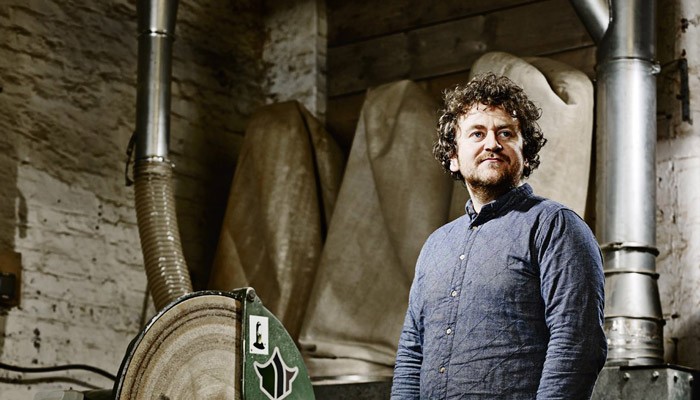MATERIAL OF CHOICE? CARDBOARD!
As we come to the end of our focus on paper this month we apply a little artistic license and introduce you to the work of Liam Hopkins who’s material of choice is cardboard! Liam’s brand Lazerian is a contemporary creative studio that manipulates established design concepts, digital technology and functional materials to create radical solutions in architectural decoration, exhibitions, lighting, furniture, jewellery and sculpture. British designer Liam Hopkins has seen Lazerian grow in capability and reputation since its inception in 2006.
‘Lazerian is committed to combining traditional handcraft techniques with the gift of modern, computer-based modelling and pattern cutting, the studio team explores new concepts in multi-dimensional design. Preoccupied by the inherent strength found in paper, wood and carbon fibre, Lazerian finds strength and beauty in the lightest and most ubiquitous of materials.’
When I contacted Liam to ask if he could tell me more about his work he was not only generous with his time but clearly extremely passionate about his work and the materials he has become an expert in using.
After graduating from Manchester Metropolian University in 3D Design Liam began to forge a path using cardboard for his furniture collaboration with artist Richard Sweeney. Liam remains thankful to Max Fraser for selecting these pieces to be part of Lab Craft, a 2009 touring exhibition curated for the Crafts Council. Lab Craft focused on the digital adventures of 26 makers who ‘combine the hand, mind and eye, technical mastery of tools and material and aesthetic sensibility, with cutting-edge digital technologies such as rapid prototyping, laser cutting, laser scanning and digital printing.’
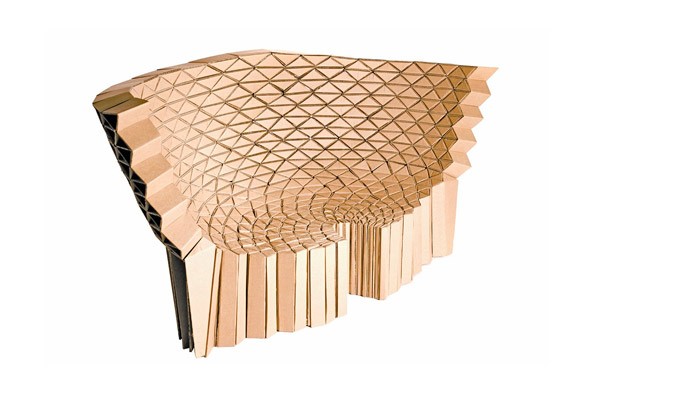
RADIOLARIAN: Inspired by structural forms in nature, including a wasp nest and the crystalline bone structure of microscopic sea organisms known as Radiolaria. Computer design techniques were used to generate the form and over two thousand components were hand cut and glued together to create the Radiolarian Sofa Limited Edition of 12.
When asked why he had chosen to work with cardboard in these early years of his design career Liam explained that cardboard, and paper, was a material which does not command peoples’ respect; it is often used for ephemeral items such as bus tickets and packaging. Popped in the bin! Liam’s wish was to elevate this under valued, everyday material, whilst creating products which spark peoples’ imagination. The use of cardboard was a natural progression from using paper and continued Liam’s exploration into maximising the integral strength of the material.
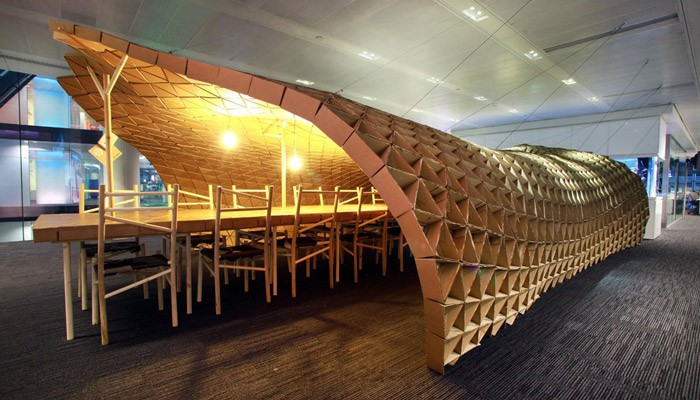
BLOOMBERG: Bloomberg approached Lazerian with the challenge of repurposing their reusable paper and board materials in a way that would remind staff and visitors of their forward-thinking credentials and environmental responsibilities.
In 2012 Liam was approached by Bloomberg to explore creative solutions in reusing workplace paper and board waste. This formed part of Bloomberg’s ‘Waste Not, Want It’ series of specially commissioned art and design projects. The result of the brief was Pupa, a digitally designed, hand-made, free-standing habitat sited within the London headquarters of Bloomberg made from reclaimed cardboard and pallets. Inspired by natural habitats, such as cocoons, bee hives, spiders’ nests and weaver birds’ nests, the installation provided a new cardboard meeting room for employees.
You may think that the cardboard in Liam’s structure looks pristine rather than built from the discarded office paperwork, however, Liam explains ‘Cardboard arrived with Lazerian in damp bales, and then taken to be pulped and re-constituted at a factory in the north of England, using machinery installed at the turn of the last century. Pupa was then assembled from individual, triangular components, an intrinsically strong form with which to develop standing and weight-bearing structures.’
In the same year Liam was approach by Mobo. Waiting to be greeted by superstars including Rita Ora, Emeli Sande and Plan B, were 28 paper dogs which were gifts for each of the award shortlisted artists. Based on the Gerald sculpture, which has become the mascot of the Lazerian studio, each dog was digitally cut from sheets of paper, constructed by hand and made unique by paint-dipping the head in the signature orange of the MOBO Awards branding.
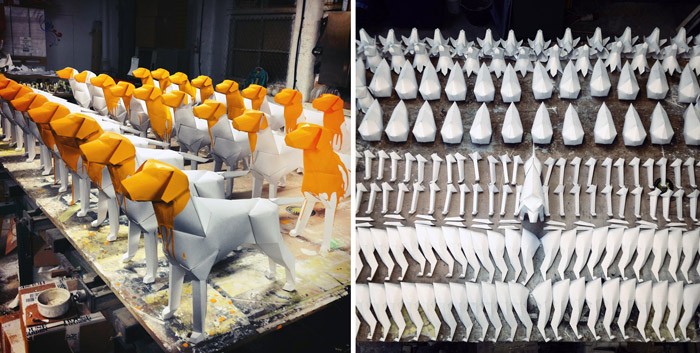
MOBO AWARDS: Lazerian was commissioned ahead of the 2012 awards ceremony, to be held at Liverpool’s Echo Arena, to create a special gift for all of the nominated artists. This was just one notable outing for Gerald on the international stage, but a proud moment for Lazerian to be able to bring together combined passions of design and the best of the world’s most renowned musical talents.
It was these projects with Bloomberg and Mobo, as well as work with Designer’s Block and Habitat which cemented Liam’s reputation as an expert in cardboard and moved his focus away from the production of his products towards batch production of limited editions and site specific installations.
Liam was commissioned by Wayne Hemingway to create an installation as part of the Art In Manufacturing series for The National Festival of Making in Blackburn, which paired leading artists with factories in Pennine Lancashire to encourage a creative expression of the histories, innovation and expertise of each, as well as amongst the people who work there.
Liam took inspiration, materials and expertise from The Cardboard Box Company in nearby Accrington to develop the show stopping invasion of indefinable ‘foreign bodies’ into an historic, formerly inaccessible building. Chromatogram (defined as being a graphic representation of the separation of components) is a physical expression of the unusual semi-isolation of workers in the modern factory.
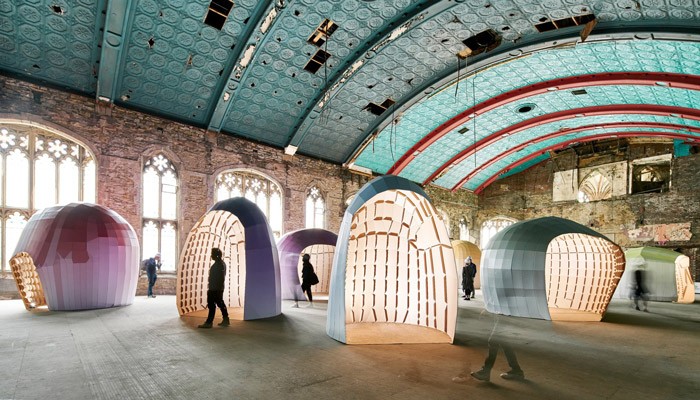
CHROMATOGRAM: The faded glory of a vast, abandoned cinema and 18 th Century Cotton Exchange in Lancashire, UK had its lost nobility temporarily revived as the backdrop to the striking installation of ‘Chromatogram’ – fifteen, 10ft tall, walk-in ‘pods’ fabricated entirely from precision-cut, individually printed cardboard modules.
“Having worked extensively with cardboard, from developing furniture and architectural installations to collectable, small-scale sculpture, the strength and versatility of the material itself presents exciting possibilities. The opportunity to use the industrial fabrication techniques of The Cardboard Box Company gave this project the potential of working to significant scale and the venue, an imposing space with such history, presented more inspiration. The result is a stark contrast between modern and archaic, meticulously planned design and that which only abandonment, nature and time has created.” Liam Hopkins
Despite a wish not to be pigeon-holed as a designer which only works in a single material Liam’s work repeatedly returns to cardboard, but he understands that it is his reputation that draws people to him with such wonderfully unique opportunities.
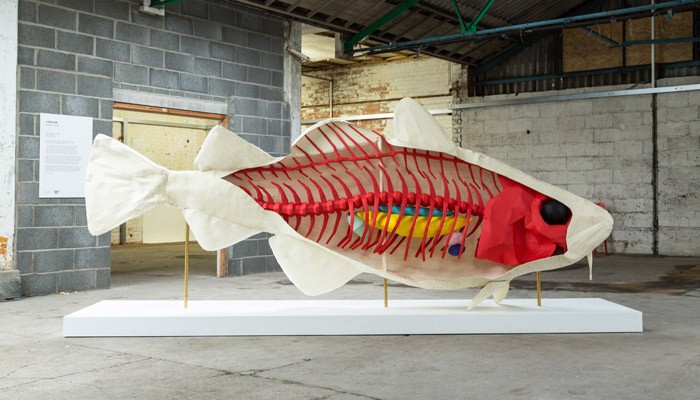
LOCAL FISH: 4m Cod paper fish sculpture for Hull 2017 City of Culture and G.F Smith. Wanting to pay tribute to Hull’s cod fishing industry, past and present, Hopkins and his Manchester-based practice Lazerian began the month-long process of creating a 4-metre-long anatomical codfish.
In 2017 Liam was commisioned to create a sculpture for Hull 2017 City of Culture. Liam was inspired by the cities historical links to the fishing industry. “There was one fishery in the 1970s that was bringing in £750 million a year,” informs Hopkins, who researched Hull’s industrial heritage extensively before embarking on the project with GF Smith. “That’s when I thought, ‘Wow! This cod fish actually holds quite a lot of power.’”
“My ethos as a designer-maker and artist is to combine digital technologies with handcraft,” says Hopkins, who used a “mixed bag” of tools and techniques to create the sculpture, including a laser cutter, a flatbed plotter, traditional scalpels, scoring aids and glue guns. “I’ve worked with paper professionally since I stated the studio 11 years ago,” he continues. “Over time, I’ve learnt ways in which to add strength to paper. It’s all about understanding its grain structure – it has a long and a short grain – much like wood.”
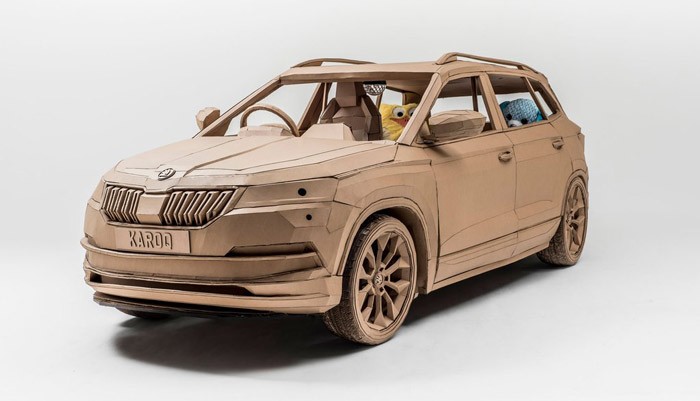
CARDBOARD SKODA KAROQ: Commissioned by Skoda to recreate the Karoq out of cardboard. With just a real car to work from Liam Hopkins had to recreate each panel from scratch. 600 hours later the LAZERIAN edition was born.
The final project in Liam’s current portfolio is his cardboard car; commissioned by Skoda to represent their survey which asked 1,000 under-11s what they’d pack into their perfect car. Liam was inspired by the survey’s results which found that almost three-quarters (72.7%) of children have built their own cardboard creations.
When I asked Liam what he is currently working on he politely explained that his current projects are under wraps; so we will need to wait and see if he has further developed his expertise in seamlessly blending cutting edge technology with traditional crafts and the art of constructing with paper, or if now is his time to break away from his material of choice!
Contact LAZERIAN





